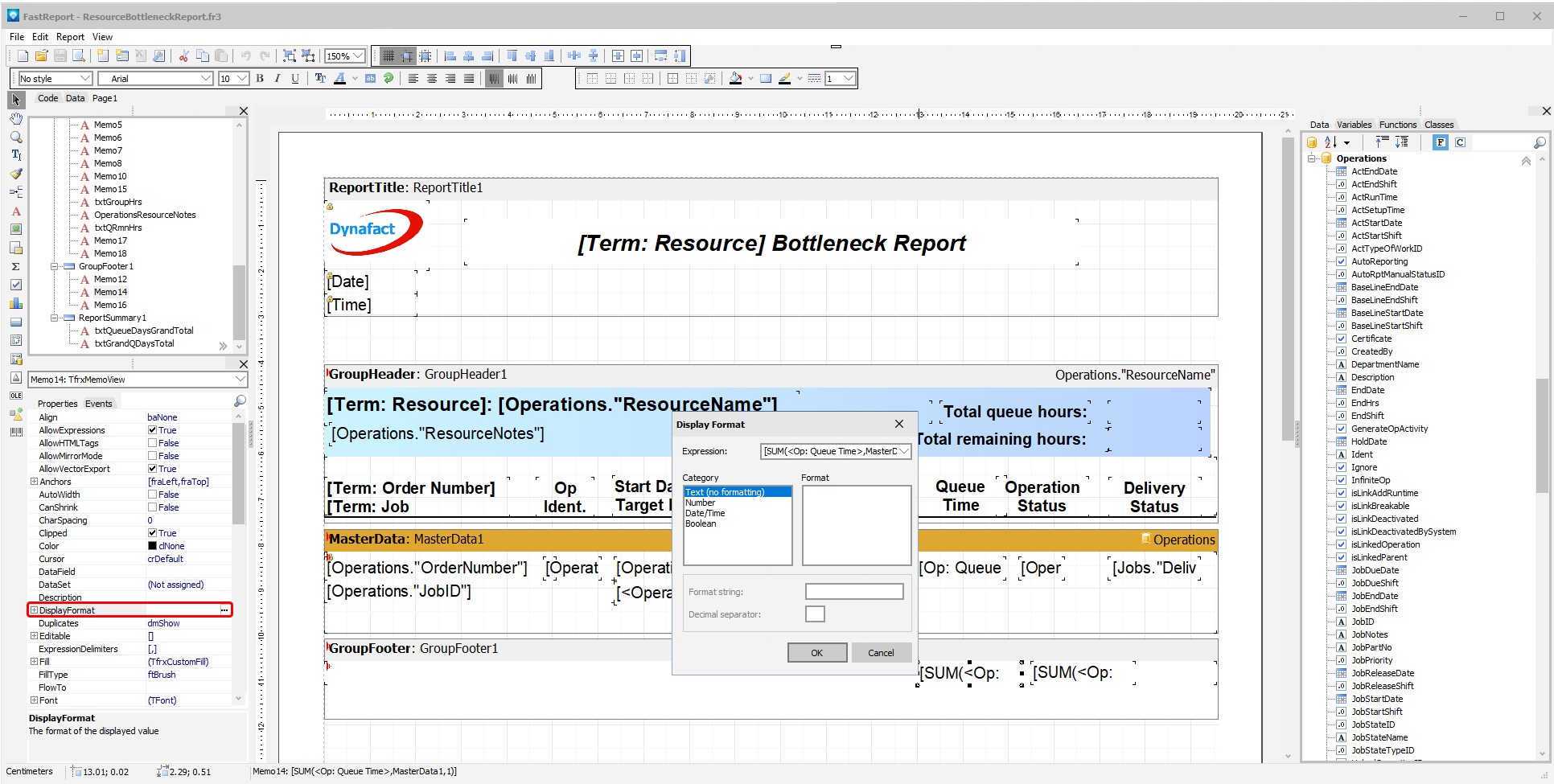Each text object, including data fields and calculated variables, has an optional display format. The display format for the object can be found in the Properties of the object on the left side of the DMS Report Designer. In the example below, the Sum Op: Queue Time is selected. By clicking on the ![]() icon next to the Display Format (circled in red in the example below) in the Properties window, the Display format window appears, enabling you to format the object:
icon next to the Display Format (circled in red in the example below) in the Properties window, the Display format window appears, enabling you to format the object:

The Display Format window has the following prompts:
1.Expression Displays the object that the format will be applied to (i.e. the data field, variable name, etc.).
2.Category The Category allows you to select between Text (no formatting), Number, Date/Time, or Boolean. Each of these categories options are described below.
3.Format String You can manually adjust the format string for a field by entering a valid string format command.
4.Decimal Separator The default decimal separator is a . but you can change it to something else as required.
Number
The Number category has 4 example formats you can choose from, or you can enter your own string format. The 4 example formats are:
1.1234.5
2.1234.50
3.$1234.50
4.$1,234.50
The format string corresponding to the selected example format is shown in the Format string prompt. Format strings contain two types of objects; literal characters and format specifiers. Literal characters are copied word for word to the resulting string. Format specifiers fetch arguments from the argument list and apply the formatting to them.
Format specifiers have the following form:
"%" [width] ["." prec] type
A format specifier begins with a % character. After the percent sign comes the following elements, in this order:
1.An optional width specifier, [width].
2.An optional precision specifier, ["." prec].
3.The conversion type character (single letter).
The format string conversion type letter can be defined as follows:
d Decimal (integer)
e Scientific
f Fixed
g General
m Money
n Number (floating)
To specify the literal percent sign % in the format string, you would use %%.
Examples of Number
1.%2.3f A fixed point number with 3 digits after the decimal point as in 13.320, 20.000, 2.500, etc.
2.%d%% A whole number with a percent sign as in 98%, 100%, 2%, etc.
3.%2.4n A fraction with 4 digits after the decimal point as in 138.1234, 9.1000, etc.
4.%2.4e Scientific notation such as 1.332E+001, 2.000E+001, etc.
5.%2.2m A money value with 2 digits after the decimal point as in $2,513.32, $20.00, $2.50, etc.
Date/Time
The Date/Time category has seven date format examples you can choose from, or you can enter your own string format. The seven formats are:
1.11.28.2002 which is a format string of mm.dd.yy
2.28 nov 2002 which is a format string of dd mmm yyyy
3.November 28, 2002 which is a format string of mmmm dd, yyyy
4.02:14 which is a format string of hh:mm
5.02:14am which is a format string of hh:mm am/pm
6.02:14:00 which is a format string of hh:mm:ss
7.02:14am, November 28, 2002 which is a format string of hh:mm am/pm, mmmm dd, yyyy
The format string has several options that can be specified to build your own date format. These are:
y Year last 2 digits
yy Year last 2 digits
yyyy Year as 4 digits
m Month number no-leading 0
mm Month number as 2 digits
mmm Month using ShortDayNames (Jan)
mmmm Month using LongDayNames (January)
d Day number no-leading 0
dd Day number as 2 digits
ddd Day using ShortDayNames (Sun)
dddd Day using LongDayNames (Sunday)
ddddd Day in ShortDateFormat
dddddd Day in LongDateFormat
c Use ShortDateFormat + LongTimeFormat
h Hour number no-leading 0
hh Hour number as 2 digits
n Minute number no-leading 0
nn Minute number as 2 digits
s Second number no-leading 0
ss Second number as 2 digits
z Milli-sec number no-leading 0s
zzz Milli-sec number as 3 digits
t Use ShortTimeFormat
tt Use LongTimeFormat
am/pm Use after h : gives 12 hours + am/pm
a/p Use after h : gives 12 hours + a/p
ampm As a/p but TimeAMString,TimePMString
/ Substituted by DateSeparator value
: Substituted by TimeSeparator value
Boolean
The Boolean category has four Boolean format examples you can choose from, or you can enter your own string format. The four formats are:
1.0,1 Either 0 for false or 1 for true will be displayed
2.No,Yes Either No for false or Yes for true will be displayed
3._,x Either _ for false or x for true will be displayed
4.False,True Either False or True will be displayed
You can enter your own values for a Boolean format where the first value before the comma is for false and the value after the comma is for true.